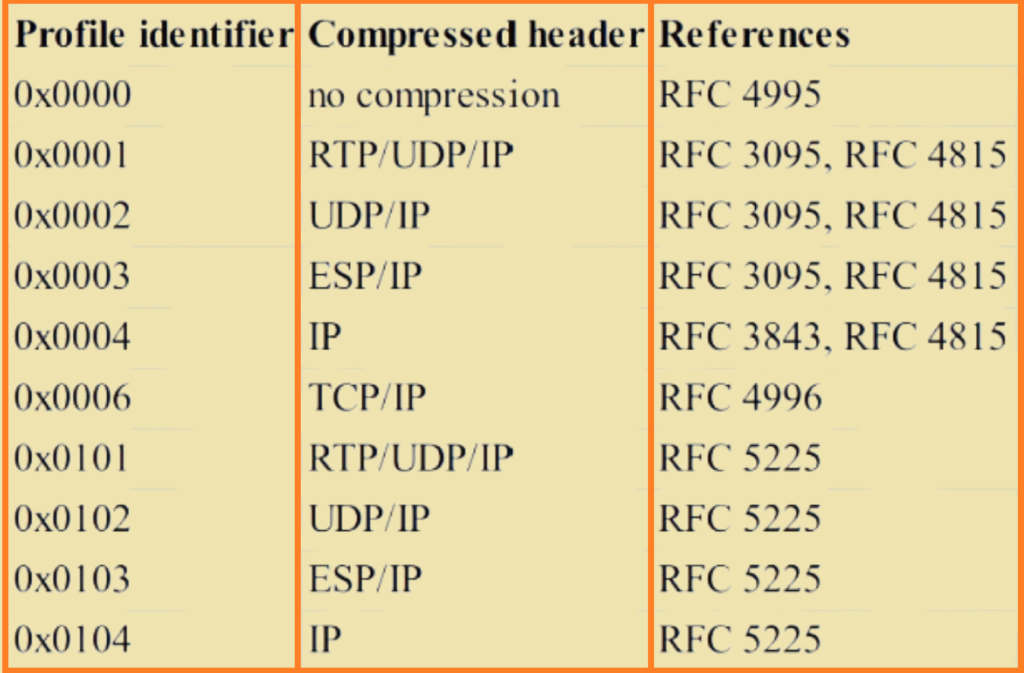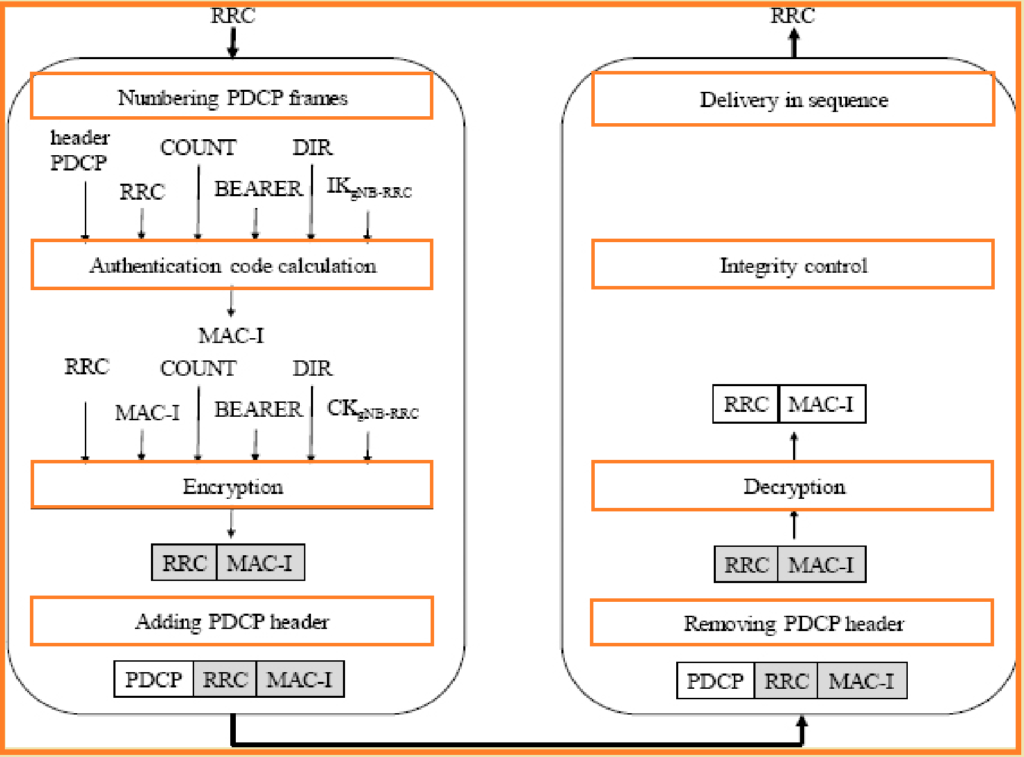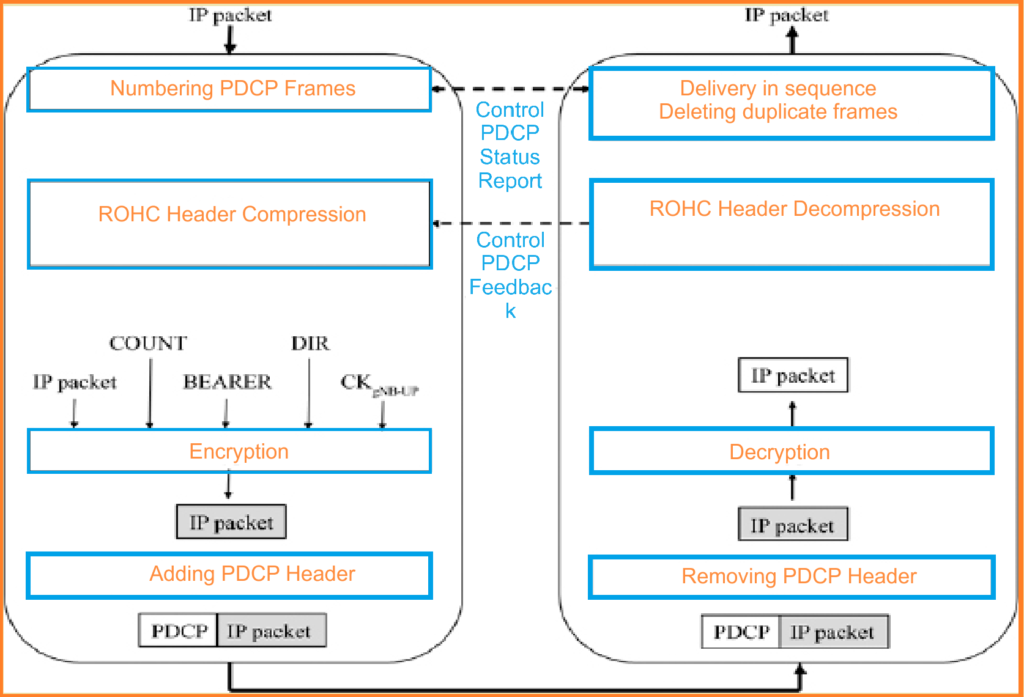In 5G NR, the Packet Data Convergence Protocol (PDCP) is used for following main functions:
- Header Compression: PDCP uses ROHC (Robust Header Compression) to reduce the size of IP packet headers. This minimizes overhead, conserves radio resources, and improves overall efficiency.
- Security: It ensures the security of RRC (Radio Resource Control) messages and signaling data through encryption and integrity protection, safeguarding against unauthorized access and tampering.
- Sequence Numbering and Delivery: PDCP assigns sequence numbers to RRC messages and IP packets, ensuring they are delivered in the correct order to maintain protocol integrity.
- Lost Frame Recovery: It supports the recovery of PDCP frames lost during handover processes, ensuring seamless continuity of data transmission when transitioning between cells or networks.
- RLC Frame Loss Handling: PDCP reestablishes lost PDCP frames if an RLC (Radio Link Control) frame is lost in acknowledged mode, enhancing reliability in packet delivery.
- Duplication Management: Detects and manages duplicated PDCP Protocol Data Units (PDUs) to prevent unnecessary processing and ensure data consistency.
- Frame Discard: It can discard PDCP frames when necessary, such as during network congestion or based on specific policies, to optimize resource utilization.
- Dual Connectivity Support: For scenarios involving dual connectivity (split-bearer), PDCP routes frames efficiently between different networks or connections, ensuring seamless data transfer and operational flexibility.
In 5G NR, PDCP manages multiple instances:
- SRB1 and SRB2: SRB1 handles RRC messages supporting NAS (Non-Access Stratum) messages, while SRB2 is dedicated solely to NAS message transmission.
- DRB Instances: Each Data Radio Bearer (DRB) has its own PDCP instance for managing user data traffic, ensuring secure and efficient transport of IP packets tailored to specific applications and services.
Procedures of PDCP.
1. Header compression.
Header compression in the 5G NR, specifically using the ROHC (Robust Header Compression) mechanism, involves several key aspects:
ROHC Algorithms: Defined by RFC specifications from the IETF, ROHC provides multiple algorithms tailored for compressing IP packet headers efficiently. These algorithms capitalize on the observation that many fields in IP headers remain unchanged across multiple packets within a session.

Effectiveness: ROHC is most effective when applied to sessions where the payload size is relatively small, such as voice data transmissions. By compressing redundant information in IP headers, ROHC reduces overhead and optimizes bandwidth utilization.

Decompression Process: The ROHC decompressor relies on feedback mechanisms provided by the PDCP (Packet Data Convergence Protocol). PDCP Feedback messages inform the ROHC compressor about the success of decompression operations or any synchronization issues that may affect compression efficiency.
Synchronization: Maintaining synchronization between the ROHC compressor and decompressor is crucial for effective header compression. PDCP Feedback messages help ensure that both ends of the communication remain aligned, minimizing errors and enhancing overall compression performance.
2. Loss of frames during handover.
During handover in 5G networks, the PDCP (Packet Data Convergence Protocol) facilitates the recovery of lost frames, provided that the Radio Link Control (RLC) protocol operates in acknowledged mode:
- Downlink Recovery: When a mobile device (UE) initiates a handover, the source gNB (gNodeB) sends an Xn-AP SN STATUS NUMBER message to the target gNB. This message includes information about PDCP frames that were transmitted to the UE but not acknowledged (unacknowledged frames), along with their Sequence Numbers (SN).
- Uplink Recovery: Similarly, the source gNB also sends Sequence Numbers (SN) of non-received PDCP frames from the UE to the target gNB, ensuring that the target gNB knows which frames were expected but not received from the UE.
Upon the mobile device successfully connecting to the target gNB during handover, the recovery of lost frames proceeds through the following steps:
- Mobile to Target gNB: The mobile sends a PDCP Status Report message to the target gNB, specifying the PDCP frames that were missing or lost during handover for the downlink direction (from gNB to UE).
- Target gNB to Mobile: In response, the target gNB sends a PDCP Status Report message back to the mobile, detailing the PDCP frames that were missing or lost during handover for the uplink direction (from UE to gNB).
3. Packet removal (PDCP discard).
In the PDCP (Packet Data Convergence Protocol) 5G NR, packet removal, also known as PDCP discard, addresses situations such as handovers or poor radio link conditions where the desired data rate cannot be maintained at the radio interface:
- Buffering for Jitter Control: Buffering PDCP packets helps mitigate jitter issues by temporarily storing data. This buffering compensates for variations in transmission delay, ensuring smoother delivery to the receiving end.
- Compensation for Reduced Data Rate: When the radio link conditions degrade, the maximum achievable data rate may fall below what is required by applications. Buffering allows the system to maintain continuity by absorbing short-term reductions in data rate.
- Deletion of PDCP Packets: In scenarios where real-time transmission is critical and buffering is not feasible or sufficient, PDCP packets can be deleted at the transmitter. This action clears the transmission buffer, ensuring timely delivery of subsequent packets.
- Frame Drop Timer: Each PDCP SDU (Service Data Unit) frame is associated with a frame drop timer. If a PDCP frame is not transmitted before the timer expires, indicating a delay or other transmission issue, the frame is deleted to prevent congestion and maintain efficient use of network resources.
4. Split bearer.
Split bearer functionality in telecommunications serves a crucial role by enabling the division of data traffic originating from the core network into two distinct paths towards a node, whether it’s a master node (MN) or a secondary node (SN). This approach facilitates efficient data transmission and management across different interfaces within the network architecture.
The primary path of the split bearer directs data traffic through the air interface directly to the User Equipment (UE). Managed by the Packet Data Convergence Protocol (PDCP) entity, this path ensures seamless delivery of data over the radio interface, optimizing transmission efficiency and reducing latency for end users.
Simultaneously, the secondary path routes data via the X2 or Xn interface to another node (SN or MN) within the network. This node then forwards the data through its own air interface to the UE. This dual-path approach allows for better resource utilization and load balancing across different network elements, enhancing overall network performance and reliability.
Split bearer functionality is essential in scenarios involving Multi-RAT Dual Connectivity (MR-DC), where the network integrates multiple radio access technologies (RATs) like LTE and NR. It supports configurations such as Dual EN-DC (eNB as master, gNB as secondary), Dual NE-DC (gNB as master, eNB as secondary), and NGEN-DC (ng-eNB as master, gNB as secondary), each optimizing resource allocation and network efficiency based on specific operational requirements.
Additionally, the split bearer architecture supports secure and efficient transmission of Radio Resource Control (RRC) signaling messages over different SRBs (Signaling Radio Bearers). These messages, encrypted and protected by the NR-PDCP entity of the master node, ensure robust communication and management of network resources across diverse connectivity scenarios.
5. PDU Duplication.
PDU (Protocol Data Unit) duplication is a feature that enhances the reliability and robustness of both user and control plane communications in telecommunication networks. This mechanism involves transmitting the same PDCP (Packet Data Convergence Protocol) frame multiple times through different RLC (Radio Link Control) sublayers. The duplication process is managed at the RRC (Radio Resource Control) layer, ensuring that the primary and secondary RLC layers are activated for each DRB (Data Radio Bearer).
In scenarios involving dual connectivity, specific configurations for PDU duplication are outlined in the Release 16 specification. For EN-DC (Evolved Universal Terrestrial Radio Access Network Dual Connectivity), duplication can be applied to the aggregation of carriers at both the master and secondary nodes, provided it is controlled by the E-UTRAN PDCP entity and there is no DC (Dual Connectivity) duplication.
For NGEN-DC (Next Generation – Dual Connectivity) or NE-DC (NR – E-UTRA Dual Connectivity), duplication is configured at the gNB (Next Generation Node B) entity. This can be at the level of the Secondary Cell Group (SCG) bearer for NGEN-DC or at the Master Cell Group (MCG) bearer master support.
In NR-DC (New Radio Dual Connectivity) scenarios, duplication is executed on both radio nodes, enhancing the reliability of data transmission. Upon reception, any duplicated packets are discarded to prevent redundancy and ensure efficient data handling. This feature is crucial in maintaining high service quality and network performance, particularly in environments requiring robust and reliable connectivity.
PDCP Operations.
1. Operations relating to the SRB bearer.
Figure below illustrates the operations associated with the SRB (Signaling Radio Bearer) bearer. When transmitting, RRC (Radio Resource Control) messages undergo a reorder procedure to help detect duplicate messages on the receiver side. Each PDCP (Packet Data Convergence Protocol) frame is checked for integrity using a Message Authentication Code for Integrity (MAC-I).

The calculation of the MAC-I involves several elements:
- The PDCP frame, which includes the PDCP header and RRC message.
- The COUNT parameter, which combines the Hyper Frame Number (HFN) and the PDCP frame sequence number.
- The DIR parameter, indicating whether the data is transmitted in the downlink or uplink direction.
- The BEARER parameter, which is the identity of the bearer (5 bits).
- The KRRCint key.
After calculating the MAC-I, the RRC message and the MAC-I authentication code are encrypted using the KRRCenc key. These are then encapsulated by the PDCP header to form the PDCP frame, which is transmitted to the RLC (Radio Link Control) layer.
Upon receiving PDCP frames from the RLC layer, the following operations are performed:
- The PDCP header is removed.
- The RRC message and MAC-I authentication code are decrypted.
- Integrity control is applied to the RRC message and PDCP header.
- RRC messages are delivered in sequence.
These steps ensure the secure and reliable transmission of control messages between network elements and the mobile device.
2. Operations relating to the DRB bearer.
In telecommunications, the DRB (Data Radio Bearer) bearer manages the transmission of IP packets, ensuring their integrity, proper sequencing, and handling during handovers. When transmitting, IP packets are assigned sequence numbers, enabling the receiver to detect and reorder duplicate or lost frames. This sequence number is particularly important during handovers, allowing retransmission requests for lost packets, provided the RLC (Radio Link Control) layer operates in acknowledgment mode.

The IP packets may undergo ROHC (Robust Header Compression) to reduce header overhead. For security, the PDCP (Packet Data Convergence Protocol) frame includes a Message Authentication Code for Integrity (MAC-I), although integrity protection for data is optional.
The calculation of MAC-I involves:
- The PDCP frame, containing the PDCP header and the RRC message.
- The COUNT parameter, aggregating the Hyper Frame Number (HFN) and the PDCP frame sequence number.
- The DIR parameter, indicating the direction of data transmission (downlink or uplink).
- The BEARER parameter, identifying the bearer (5 bits).
- The KUPint key.
The IP packet is encrypted using the KUPenc key. If integrity protection is applied, the MAC-I seal is encrypted with the KUPint key before being encapsulated by the PDCP header to form the PDCP frame, which is then forwarded to the RLC layer.
Upon receiving PDCP frames from the RLC layer, the following operations are performed:
- The PDCP header is removed.
- The integrity seal is verified.
- The IP packet is decrypted.
- The IP packet is optionally decompressed.
- Duplicate PDCP frames are removed, and IP packets are delivered in sequence.
The PDCP feedback control message verifies the header compression procedure. The PDCP Status Report control message facilitates the recovery of frames lost during handovers. Note that control messages of the PDCP, known as Control PDCP PDUs, are not protected for integrity.